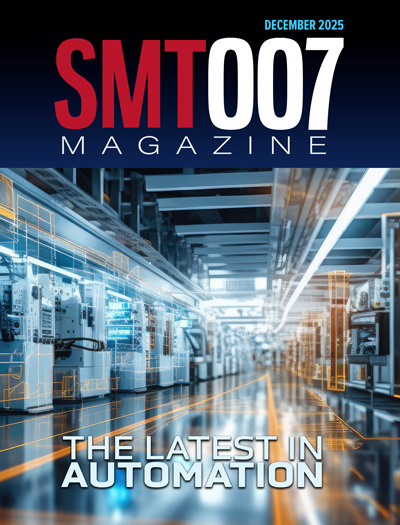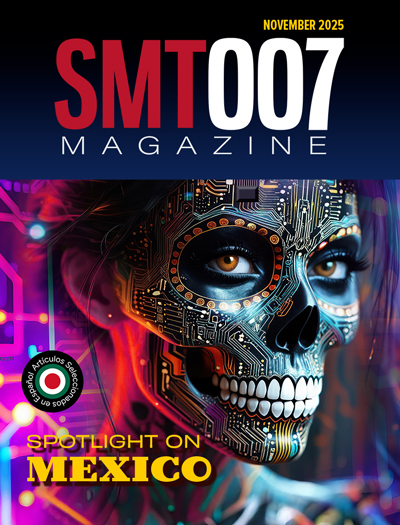-

- News
- Books
Featured Books
- smt007 Magazine
Latest Issues
Current Issue
The Latest in Automation
When customer requirements shift, responses range from new equipment to automation. Explore the newest solutions reshaping production and how today’s market dynamics are driving these trends.

Spotlight on Mexico
Mexico isn’t just part of the electronics manufacturing conversation—it’s leading it. From growing investments to cross-border collaborations, Mexico is fast becoming the center of electronics in North America. This issue includes bilingual content, with all feature articles available in both English and Spanish.

Production Software Integration
EMS companies need advanced software systems to thrive and compete. But these systems require significant effort to integrate and deploy. What is the reality, and how can we make it easier for everyone?
- Articles
- Columns
- Links
- Media kit
||| MENU - smt007 Magazine
Achieving Repeatable, Consistent Control over the Selective Soldering Production Process
February 1, 2017 | Gerjan Diepstraten, Vitronics Soltec B.V.Estimated reading time: 5 minutes
Abstract
Selective soldering is a process with more than 100 different parameters that may impact soldering performance. Some conditions change over time (e.g., machine temperature, humidity, contamination, wear of parts or settings after maintenance). Other factors in the process include the materials used, component wettability, solder mask surface energy, board material Tg and Td values, solder oxidation and composition.
During production, conditions may begin to drift. In order to avoid solder defects, statistical process control or SPC is the best method of identifying unexpected changes in the process. When using this statistical technique, however, it is important that the machine has the tools to measure these essential process parameters and if necessary control them to maintain a robust soldering process. Apart from machine parameters, the materials have a big impact. A robust selective soldering process should have a wide process window that is able to handle variations in material quality. In this paper, critical process parameters are discussed as well as methods that can be used to widen the process window. Additionally, process robustness is evaluated.
Introduction
Selective soldering machines are available in many different configurations, primarily because the assemblies are very different, not only in design, width and mass, but also in volume and in the number of solder joints.
Nevertheless, they all require the same three sub-processes of fluxing, preheating and soldering. These processes can have different methods, but in the end all main parameters are identical to create a solder connection: the amount of flux per area, preheat temperature, solder temperature, and contact time.
Machine and Process Capability
A machine capability analysis may be applied to a selective soldering machine to ascertain its suitability to flux, preheat and solder a circuit assembly. It is a short-term study with the sole aim of discovering the machine-specific effects on the soldering process.
Process capability is more of a long-term study. In addition to variations arising from the machine, all other external factors that influence the soldering process over a longer operating period must be taken into account.
Process capability can only be performed directly on the production line. Parameters tested may include topside board temperature and solder contact time. Parameters that influence the process and are related to the materials that are used include the printed circuit board itself.
Selective soldering is a method often used in the automotive industry. Machine capability is part of the quality program that ISO-certificated companies ascribe to. The ISO auditor may want to see how the company assures the assembly process. Quality tools including process FMEA, machine capability analysis, process capability and statistical process control are part of their daily business.
A machine capability analysis (MCA) is typically done before the acceptance of the machine, when the machine is installed in the production line and/or when the machine is moved to another place in the manufacturing facility to ensure that the performance of the machine is not affected. Some automotive customers require a MCA before a new production line starts up that is dedicated to a specific (new) product/model.
Fluxing Process
The majority of flux application systems in selective soldering are dropjet devices. In the flux process there are some very important parameters that may affect reliability. The most critical is when flux penetrates into a SMD or other area where it is not activated, due to lower process temperatures. Non-activated flux in combination with humidity can cause electro-migration when the product is used in the field. Therefore, the spreading of the flux is the most critical parameter in this process, although it may have no impact on the final soldering result. This is a problem because engineers focus on soldering results and not on flux residues that are very hard to identify. To avoid reliability risk, it is the best to choose a selective soldering flux that is inert even when it isn’t activated[2].
Today many engineers are struggling to control the applied flux amounts. For good soldering, more flux is sometimes needed. Applying more flux creates, however, the potential risk that flux may penetrate into SMD areas.
To avoid this, it is important to understand properties of flux and the printed circuit board.
The solder mask on the PCB is an important component that significantly impacts the spreading of the flux. The flux spread depends on several factors, including the following:
- Flux surface tension (flux type)
- Surface energy of the board (solder mask)
- Temperature of the flux
- Temperature of the board
- Flux amount
As one may notice, none of these are machine parameters expect for the flux amount that can be controlled by adjusting flux machine parameters.
The situation is even more complex. Flux spreading is critical for reliability, but the amount of dry solids of flux per square inch affects soldering quality. Thus, a trend in new fluxes for selective soldering is to increase flux solid content, which allows minor flux (less spreading) and yet retains a high concentration of solids in the soldering area.
A typical soldering process requires 500–2000 μg/in² solids.
Figure 1: Higher surface energy of solder mask makes flux flow.
Figure 1 shows the impact of the flux surface tension and the surface energy of the solder mask on flux spreading. Printed circuit boards made for the wave soldering process may fail in selective soldering due to the higher surface energy of the solder mask that makes the flux spread away from the soldering area.
All of these different parameters affecting the spreading (and thus also the amount of flux per square inch) makes it complicated to effect a process control on this critical process parameter. The surface tension of a flux (influenced by surfactants in flux) isn’t even defined in the datasheet. The surface energy of the solder mask can be measured using simple ink pencils with different inks.
Figure 2: Ink pencils to help define surface energy of a PCB.
The line of ink should remain unchanged for two seconds without turning into droplets; this indicates that the surface energy of the board is the same or higher than the surface tension of the ink. A typical value for selective soldering is 35 mN/m.
This parameter will not change from board to board, but requires verification when a different batch of bare boards are used.
To read this entire article, which appeared in the April 2016 issue of SMT Magazine, click here.
Testimonial
"Advertising in PCB007 Magazine has been a great way to showcase our bare board testers to the right audience. The I-Connect007 team makes the process smooth and professional. We’re proud to be featured in such a trusted publication."
Klaus Koziol - atgSuggested Items
IPC Hand Soldering Competition 2026 UK Regional Qualification Opens Registration
01/05/2026 | Global Electronics AssociationThe IPC Hand Soldering Competition (HSC) 2026 UK Regional Qualification will take place from 3–5 February 2026 at the Farnborough International Exhibition Centre, bringing together top electronics manufacturing professionals to showcase their precision soldering skills.
Apollo Seiko Brings Expanded Selective Soldering Lineup and New Dual-Pot Innovations to APEX 2026
12/22/2025 | Apollo SeikoApollo Seiko, a leading innovator in soldering technology, will showcase its largest APEX presence to date in Booth 1300, featuring a full 30×40-ft display dedicated to next-generation selective soldering technology and advanced soldering automation.
SMTA Space Coast: What's Needed to Modernize Defense Solder Standards
12/23/2025 | Nolan Johnson, I-Connect007Long-time lead-free solder investigator, Denny Fritz, hit the SMTA Space Coast Expo in November to drum up support for an initiative to include lead-free solder in milaero-based printed circuit board assemblies. In this interview, Denny provides background on the genesis of the “consider all solders” project and why it matters to continue leading this effort.
SolderKing to Reinforce UK Manufacturing and Supply Reliability at Southern Manufacturing & Electronics 2026
12/18/2025 | SolderKing Assembly Materials Ltd,At the show, SolderKing will be highlighting its UK-manufactured range of solder wire, solder paste and flux products, supported by a wider consumables’ portfolio developed to support stable, repeatable and compliant electronics assembly across industrial and OEM manufacturing environments.
AIM Solder Signs New Distributor in Vietnam
12/17/2025 | AIM SolderAIM Solder, a leading global manufacturer of solder assembly materials for the electronics industry, is pleased to announce the signing of RMG Vietnam Co., Ltd for distribution in Vietnam.


